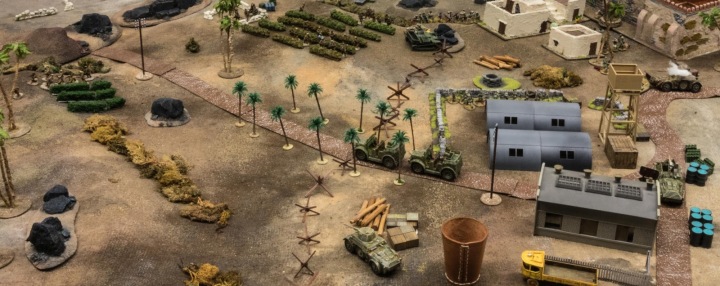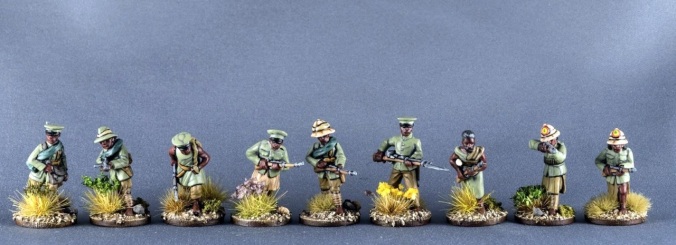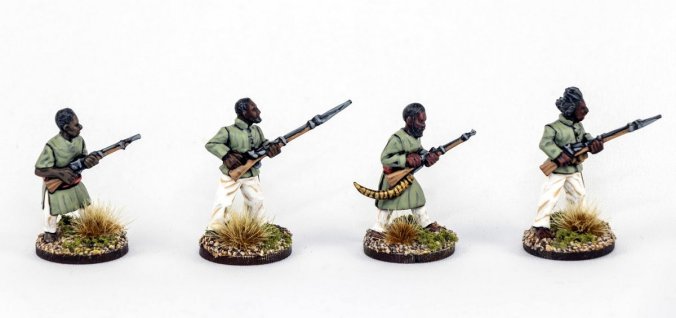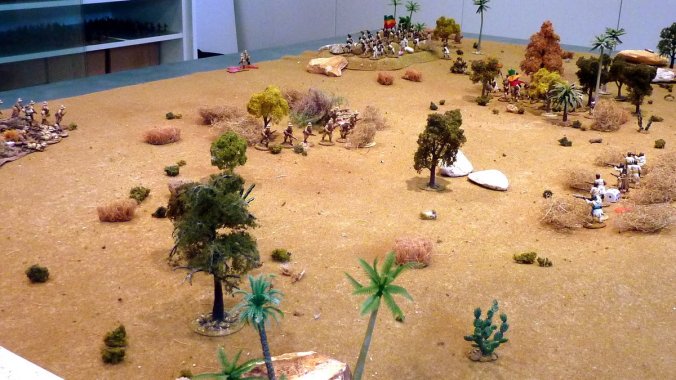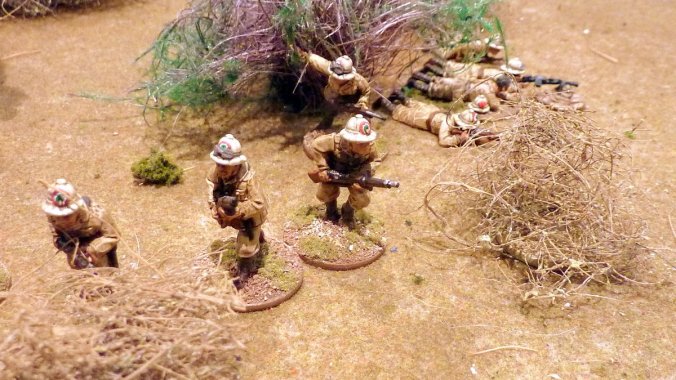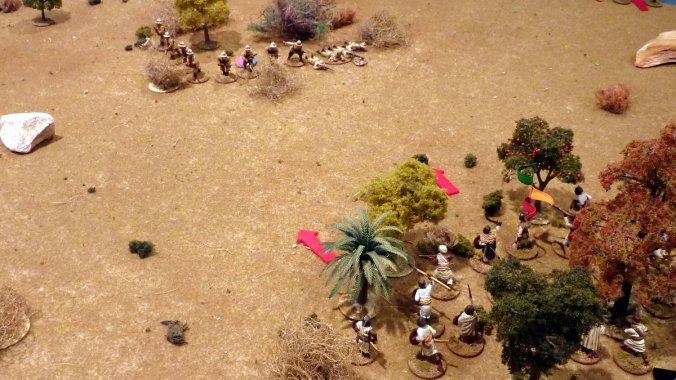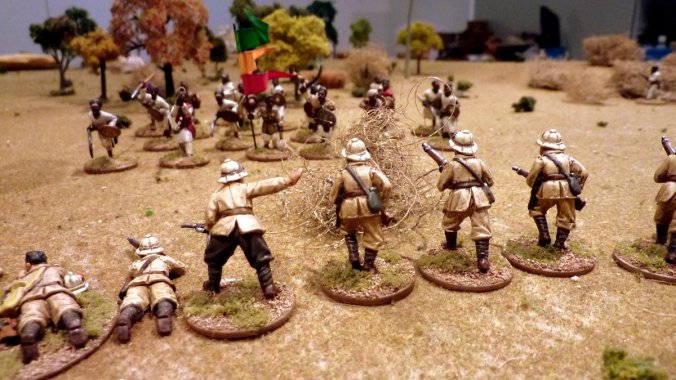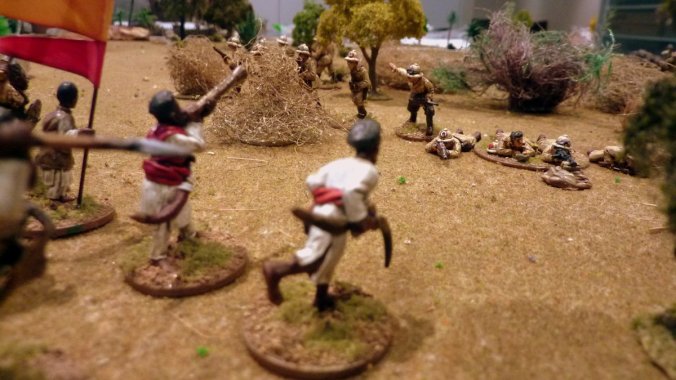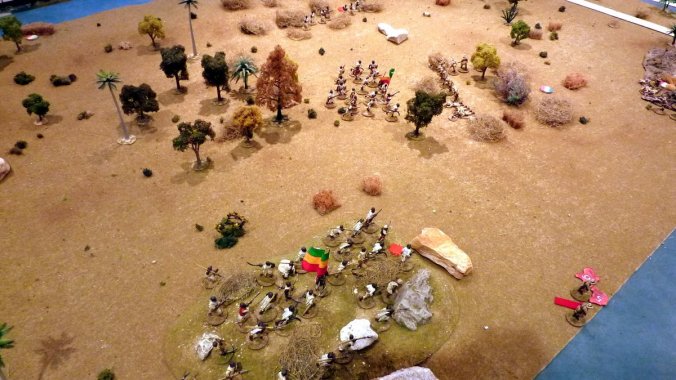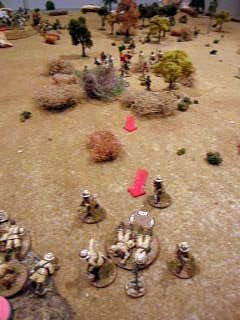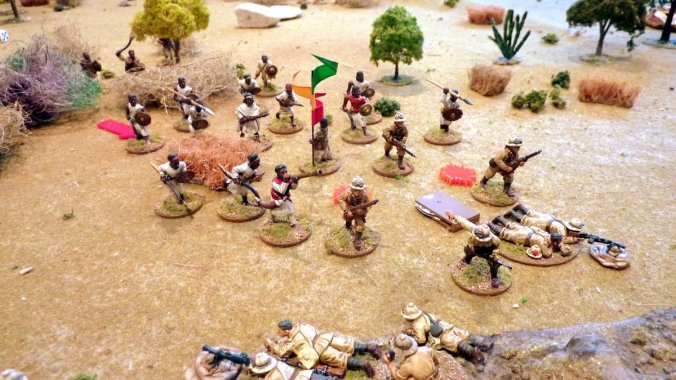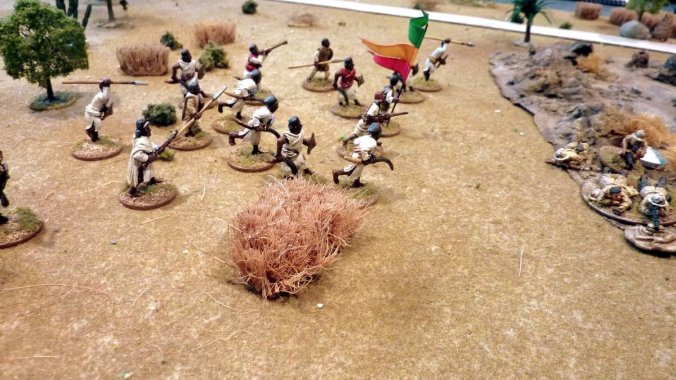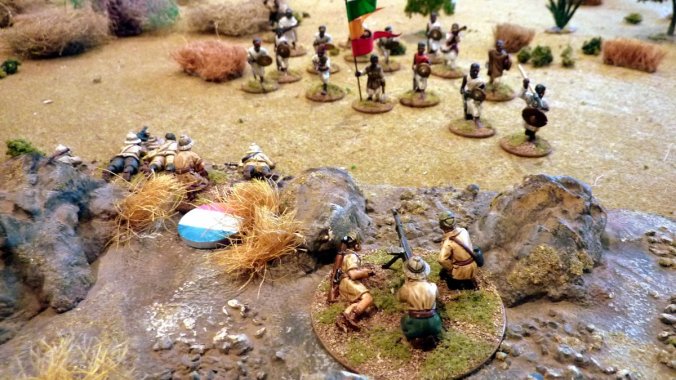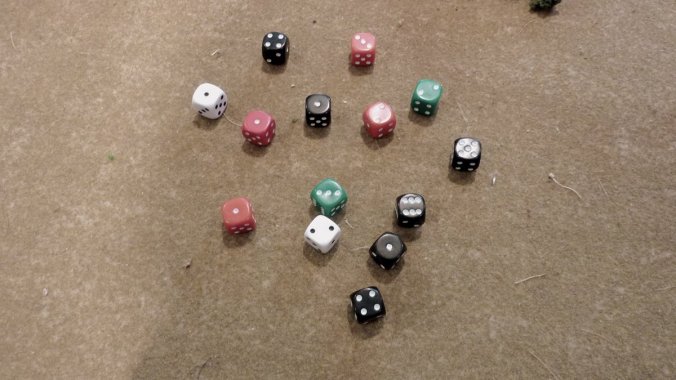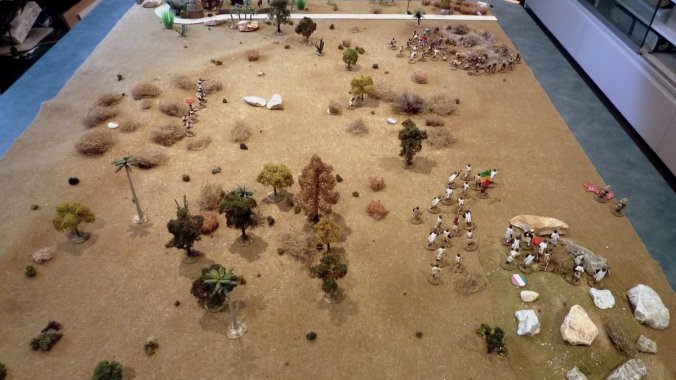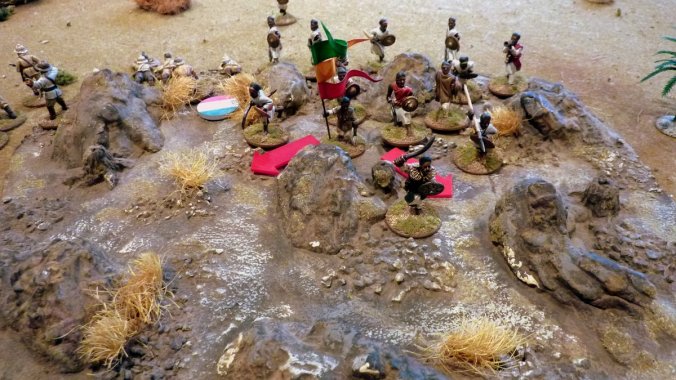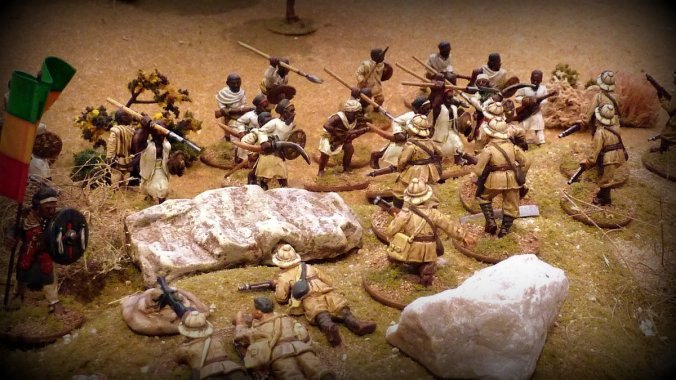
“…they emerged from caves, we barely saw them before the glint of steel with howling screams filled the air. Blood and steal mixed in a maelstrom of fury atop the hill. It was a desperate struggle and the squad leader, Caporal Giuseppe, fell leading his men along with many others in the desperate struggle. For us, all was lost, mercifully a few of us got away to tell the tale…”
…Fucilieri Antonino Brazingo, at the action of Mai Timchet, December 15, 1935
ψ
The past three posts we’ve discussed numerous options and ideas about fielding an Ethiopian Chitet force, specifically focusing on the many unique aspects when using this force in Chain of Command: Abyssinia. In this post we look at some of these principles in action with an engagement between an Ethiopian Chitet force and an Italian Fucilieri platoon.
Situation
It is December 1935 and on the northern front the Italians have steadily been advancing meeting only localised Ethiopian resistance. In the opening operations of the Ethiopian Christmas Offensive a sharp engagement occurred on the banks of the Tacazze River near Mai Timchet. Elements of the Italian II corps are engaged by the forces of Ras Imru.
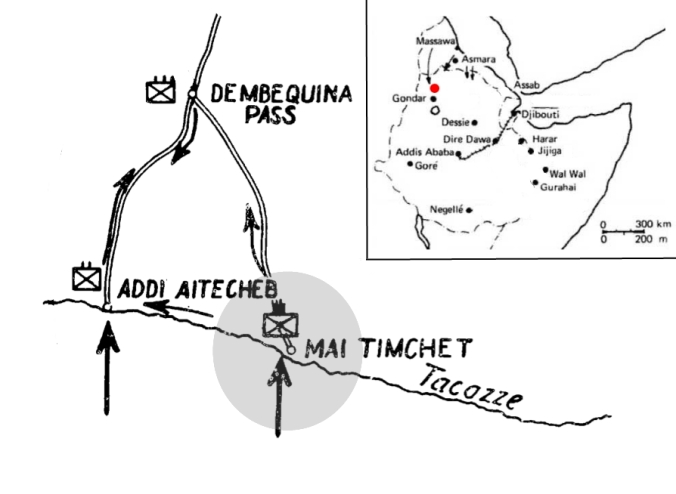
Game Set up
Forces
We shall play Chain of Command Scenario Three: Attack & Defend to reflect the offensive movement of Ras Imru’s chitet across the Tacazze. We’ll assume the baluch has crossed the river and is now moving on a small outpost leading into the town of Mai Timchet. In this scenario we’ll take a standard Italian platoon and the Chitet shall represent a force relying on relatively large but poorly commanded hazbs (sections) as discussed in the previous post.
These two platoons against one another provides an initial Platoon Force Rating split of (-1 to +3) i.e. four points in favour of the Ethiopians. In the subsequent roll for additional support forces the Ethiopian player scores an 8 giving him a final total of 12 support points to spend (8+4=12). The Italians gain 4 support lists points (i.e. half of the dice score rolled by the Ethiopian player).
Italian Forces
A typical Italian platoon using the Regno Esercito and CCNN army list is made up as follows;
Platoon Force Rating; Regular +3 – Command Dice 5
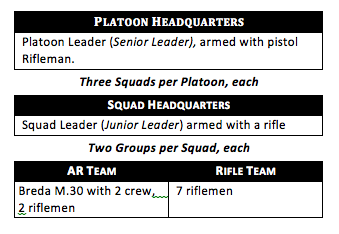
- Special Rules: None
- Support list choices; 4 support list points.
- MMG on tripod with 4 crew = 4 SL
Ethiopian Forces
Platoon Force Rating; Regular -1 – Command Dice 4
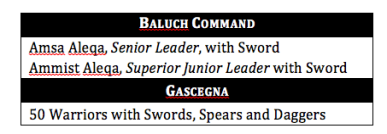
- Special Rules: Aggressive and Sons of Adwa
- Support list choices; 12 support list points.
- Flag = 2 SL
- Cave = 2SL
- Tribal Rifles = 1 SL
- Additional Men = 7 selections (i.e. 7×5=35 men) = 7 SL
The Gascegna shall be divided up as follows;
- 1st hazb – 20men
- 2nd hazb – 20men
- 3rd hazb – 20men
- 4th hazb – 15men (ten with tribal rifles)
- 5th hazb – 10 men
Notes – The Italian player has chosen to use a MMG to bolster his defensive position – his only support list choice but he should have plenty of targets! The Ethiopian Chitet player has gone for a fairly large but cumbersome force….men, men and more men! It incorporates some firepower but predominately is a close combat force, the very essence of a warrior culture. The intent will be to overwhelm the Italian defenders by using the Flag command to issue orders to provide principle command and control in a simple but effective way, which will off course be limited as there are only four command dice available…we shall see how it goes!
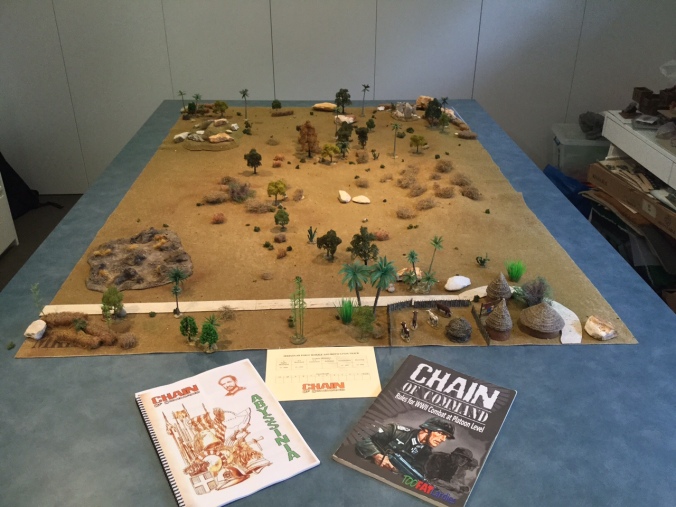
.
Irregular rules to take note of;
Just before we leap into the action it’d be prudent to just touch on some of the more important aspects of the irregular troop rules in Chain of Command:Abyssinia to refresh our memory. If you’re going to command tribals you need to be familiar with how they work, just as you’d need to know the vehicle rules if you were running an armoured car or tank. So, here are a few quick reminders;
- Unit Size – remember to keep track of the number of figures in a unit as the size of a unit at any specific moment is what matters, not what size it started at.
- Movement – 3d6″, no shock….run as much as you like.
- Motivation – units are in one of six possible motivation states as shown on the motivation record track. If it’s high you get combat bonuses and modifiers to pass fire & combat effect tests. If it’s low the opposite is true.
- Chain of Command dice – if you get one save it so you may influence when the Turn ends (by forcing a Turn end or preventing it) which will likely impact on your motivation; remember, motivation returns to the ‘neutral’ Committed state when the Turn ends…always.
- Leaders – a leader can attempt to lift off a pin marker anytime he expends 1 command initiative in a phase by a score of 6 on one D6 per CI spent.
- Pins – units can attempt to lift of their own pin markers if activated in a phase. However they must follow the result, unless they have an attached leader, who counters any negative test attempt….a benefit of having a leader attached, whether activated or not.
That more or less covers off on the main points for Irregular troops. Also note that your support list choices can influence the irregular rules, for example, your Flag allows you to ignore a shock hit and War Drums gives you a +1 bonus on fire and combat tests, and so on. All these factors should be part of your initial thinking when putting your force together….if you turn up unprepared you may miss an important rule that can help you! Ok, onto the patrol phase…
.
.
Patrol Phase
The patrol phase played out as follows.
As the attacker the Ethiopian player rolls 1D6 to determine his ‘free’ patrol marker movements before the game starts. He scores a ‘3’ giving him three free moves before the patrol phase begins proper. These free moves combined with the Chitet Infiltration ability allows the Ethiopian player to move his patrol markers 14″ instead of the usual 12″ thereby gaining an excellent starting advantage at this stage of the game.
Force Morale is now rolled for both sides. The Italian player rolls a ‘3’ giving him a starting force morale of 9 and the Ethiopian player rolls a 1 giving him a not so good starting force morale of 8. Finally the Ethiopian Motivation Level needs to be set. The Ethiopian player rolls a 4, adding +1 to the the die for the ‘Sons of Adwa‘ trait, resulting in the chitet final score of ‘5’ that being ‘Motiviated’. This will help them pass irregular morale tests (+1drm) and give them some sting in combat (+2D6).

Ethiopian force morale at ‘8’ and their enthusiasm is set at ‘Motivated’. Italian force morale is 9.
SCENARIO OBJECTIVE: To win a victory, one side must force his opponent to withdraw from the table, either voluntarily or due to a reduction in his Force Morale, whilst keeping his own Force Morale at 3 or greater. If neither side achieves this, both will withdraw, neither gaining control of no‐man’s‐land, the result being a dishonourable draw.
.
.
The beginning of the patrol phase had the the initial markers placed as so;

.
.
At the conclusion of the Patrol Phase Jump off points are indicated as follows.
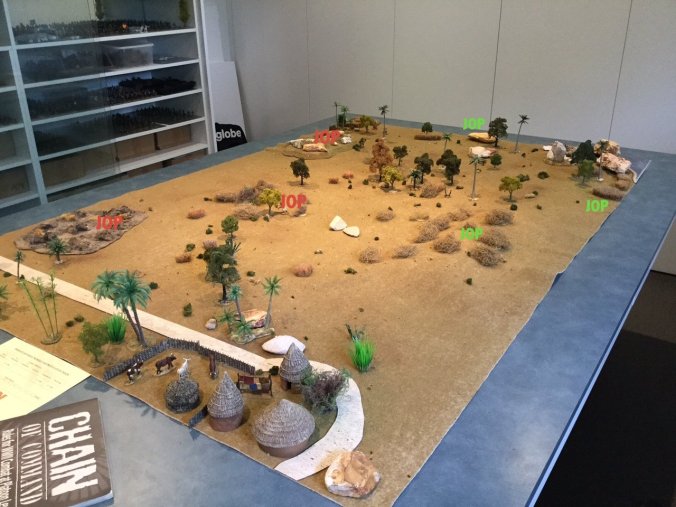
The Italians made the most of the patrol phase by moving (first) as they had the higher force morale. They advanced with the idea of moving forward quickly to ‘lock down’ the chitet patrol markers to minimise their patrol phase ‘infiltration’ advantage. The Italian player must always be mindful of the greater scouting and patrolling ability (i.e. Infiltration) of the Ethiopian player and in this game the Italians correctly realised that limiting enemy movement potential to undermine their battle plan right from the start would be a good idea. To a degree they achieved this.
The Ethiopian player ends up with two JOPs in useful positions with the third on his baseline offering him less advantage. The JOP on the short table edge however was a very useful location as when coupled with the Cave attribute it essentially enables a kind of ‘mass ambush’ potential to the chitet force.
.
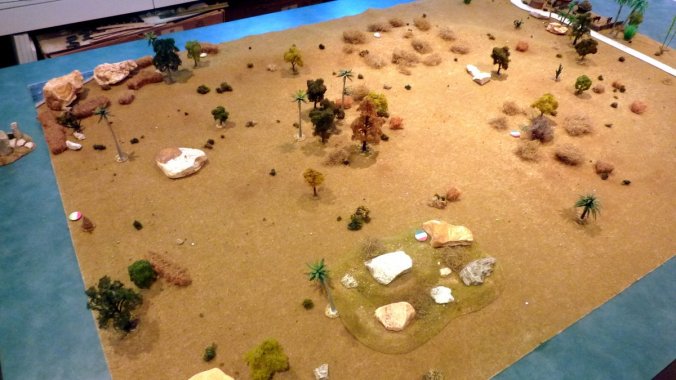
In this overview you can see three Ethiopian JOPs and two Italian ones on the rocky outcrop and scrubby cover.
.
.
.
Combat!
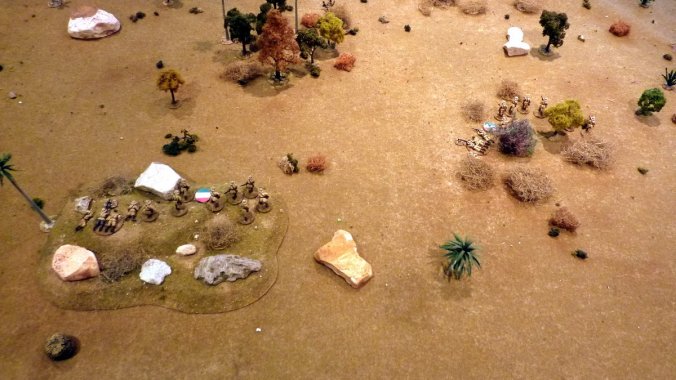
Sections one and two deployed and ready for action
The Italians start the action by immediately deploying troops into their defensive positions. They place a section on the rocky outcrop and another in scrub, both providing good fields of fire and light cover for the impending Ethiopian attack. Their plan was to use the ground as much as they could and be able to interdict any Ethiopian move to grab any of their JOPS by fire dominance alone, as each JOP was isolated from the other.
.
.
.
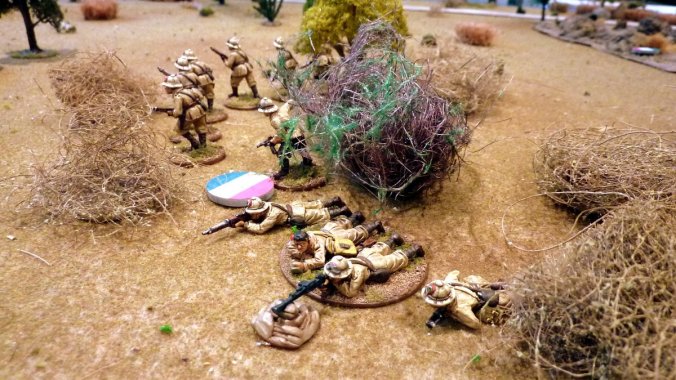
Typical Italian section – rifle section covers to the right, the Breda team the left, with the section leader placed to control their fire.
An Italian section in the centre of the field was used to cover any front or flank movements by the Ethiopians. As the Ethiopians can move 3D6″ and with no shock effects rapid movement by the enemy can be expected so good fields of fire are important when establishing a defensive position.
.
.
.
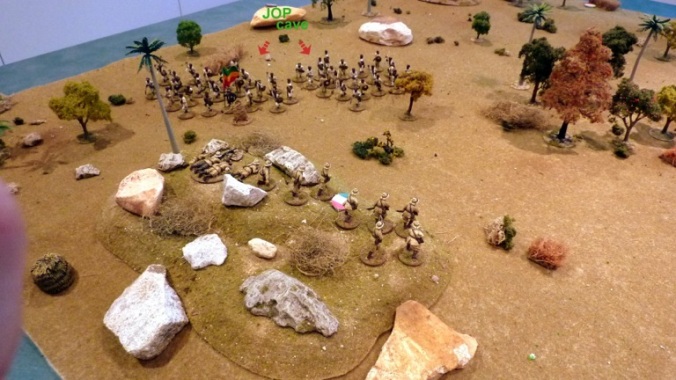
Attack!!!
The opening Ethiopian phase saw them deploy as fast as possible. Only rolling four dice they nevertheless scored quite well getting both a Senior leader score ‘4’ and two ‘2s’ enabling two units to deploy…very well planned! Both units emerge from the JOP, one designated as their ‘Cave‘ which combined with their Infiltration trait that enables a 9″ deployment distance from their JOP with an additional 6″ of movement for this unit, thus they’re able to rapidly emerge in front of the Italian position near the rocky ground.
In addition the Amsa Aleqa senior leader deploys with this group of warriors with one hazb also including the Flag. Clearly this is the major ‘push’ planned by the Ethiopian commander to capture a Italain JOP immediately to gain a quick success and hope to increase his force’s motivation level.
This was clearly going to be an ‘overrun operation’ not an ‘prepared assault’ and he planned on using their size and speed to every advantage. By getting as many troops on table as fast possible the Ethiopians hope to intimidate the Italians and present him with multiple targets to disperse his firepower.
(Note – another option, not used here, that is a hugely useful ability is to redeploy a JOP if you are able to deploy before your opponent gets troops down i.e. you start the game with a higher force morale or he neglects to introduce troops immediately to cover vulnerable JOPs. This trait can shift a JOP to within 12″ of an enemy JOP and then have one or more units deploy 9″ from it…this alone could enable a unit to compromise an enemy JOP from the very first phase…those irregulars really can just appear!).
.
.
.
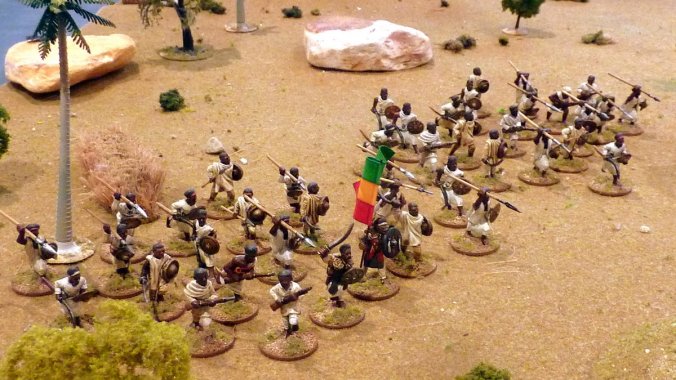
Close up of the chitet emerging from their ‘caves’.
.
.
.
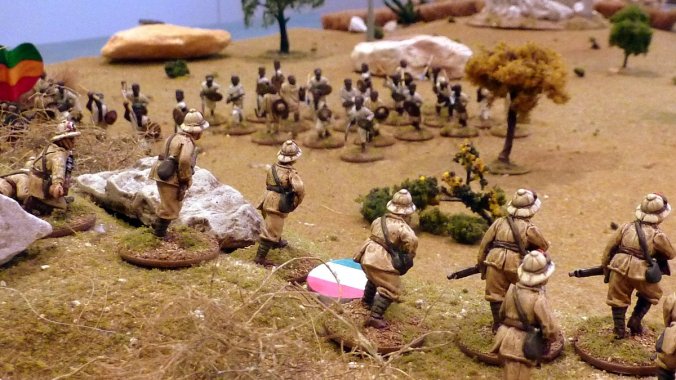
“…Steady men, prepare to fire…fire!…”
The squad leader immediately gives the order to shoot! The squad erupts in a cacophony of rifle fire and spluttering Breda fire all to no avail as the fire effect, whilst causing some shock, was not enough to trigger a morale test on one hazb, whilst the other passed its fire combat check due to its motivation level being unite good (+1drm). In addition the Flag enabled one of the shock to be ignored and this alone meant the first hazb fire effect test was not required.
.
.
.
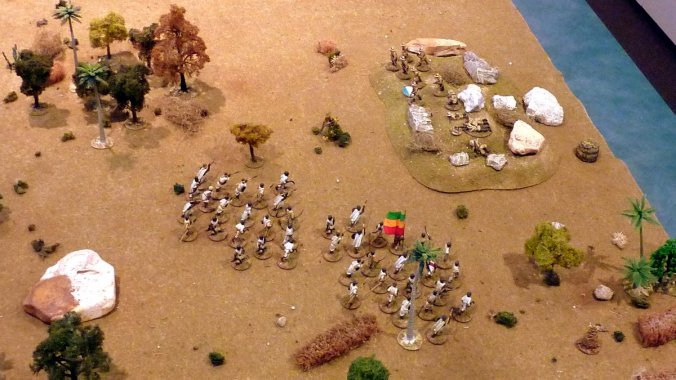
Here you can see just how quickly the chitet can ‘move up’ on an opponent by their infiltration ability, enhanced with their cave support list option.
.
.
.
.
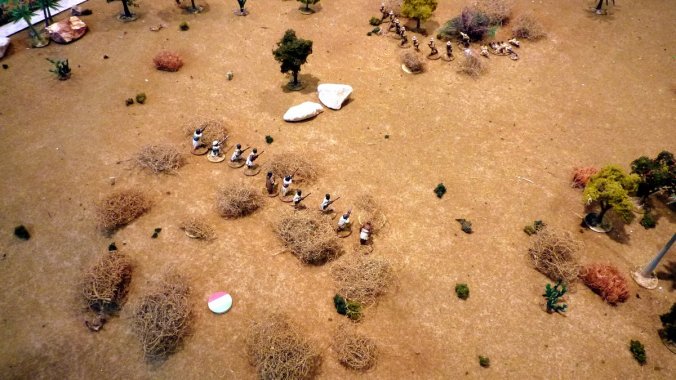
In the following Ethiopian phase chitet forces now started to appear from a different direction to further complicate the Italian defence. The activation dice enabled a unit of riflemen to deploy on the opposite flank to bring down harassing fire and split the Italian commander’s attention…enemy to the front and flank with one position close to be under immediate attack!
.
.
.
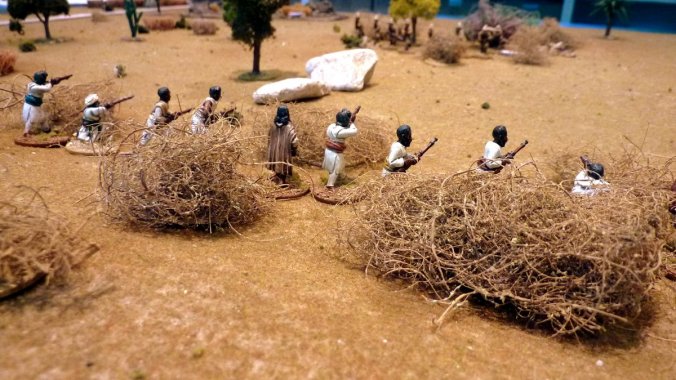
“…shoot, fire…faster, faster…”
The chitet riflemen, all armed with tribal rifles, cause no result on the Italian squad to their front when they emerge from their JOP in the scrub.
.
.
.
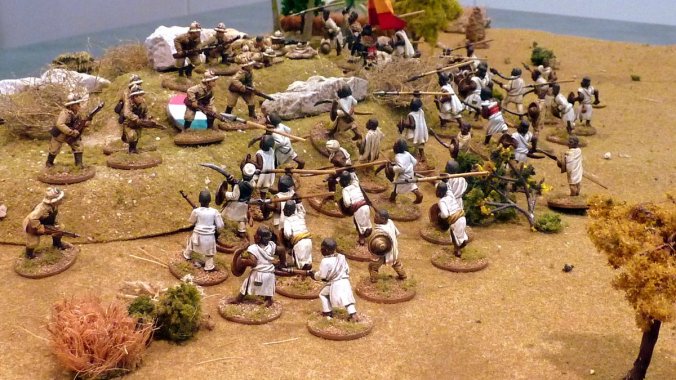
“…death to the invader…”
In the same phase the command dice enables the Amsa Aleqa (SL) to be activated and a Chain of Command dice to be increased. He immediately issues a command by Flag! With the appropriate flag waving signalling the attack (by using two of his command initiatives) both hazbs were able to move on this order to immediately assault the Italian position…combat in the second phase!
(The ability of the Flag command to issue multiple unit commands can be seen here as only the senior leader need be activated on the command dice…a reasonably achievable result even with only four command dice).
.
.
.
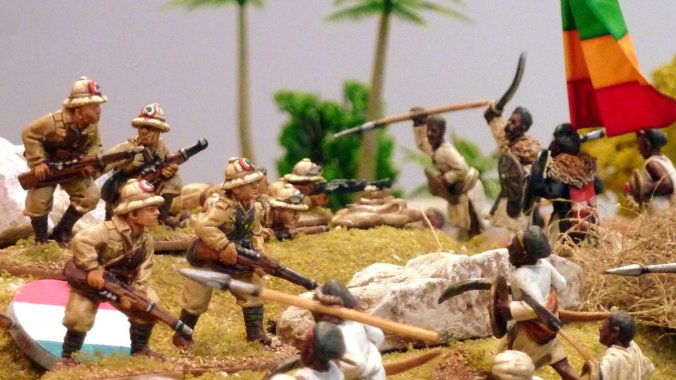
With every man ready for the fight the shear terror of the massed assault by the Ethiopians struck fear into the hearts of the fucilieri. They opened up with a final defensive fire as the combat unfolds.
.
.
.
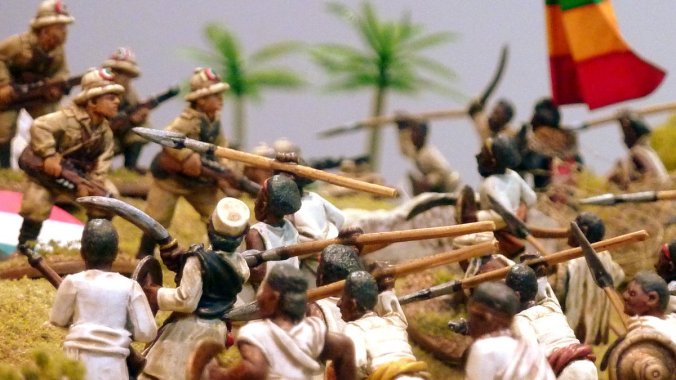
With every bullet expanded there simply isn’t enough time to deliver the requisite volume of effective fire to stop the human wave assault. Virtually cut down to a man, they lose ten of the twelve man section including their junior leader who is killed outright…a huge blow for the Italian player in the opening stage of the game.
The Italians are nothing if not tough and they dish out nine kills of their own on the chitet before they finally fall. Even though the Ethiopians take loses , their victory in combat negates the need to check for a combat effect as the euphoria of victory surges within them.
(To give you some idea of the weight of this attack, the Ethiopian player rolled 60!…yes 60 combat dice to the Italians 24 or so. It is worth pointing out the chain of command rule on p59… “When one side is sending multiple Teams or Sections into a Close Combat in the same Phase, they may choose whether these are sent in to fight simultaneously or one at a time.” This clearly works to the advantage of large irregular forces than can overwhelm isolated enemy positions – take note!)
.
.
.
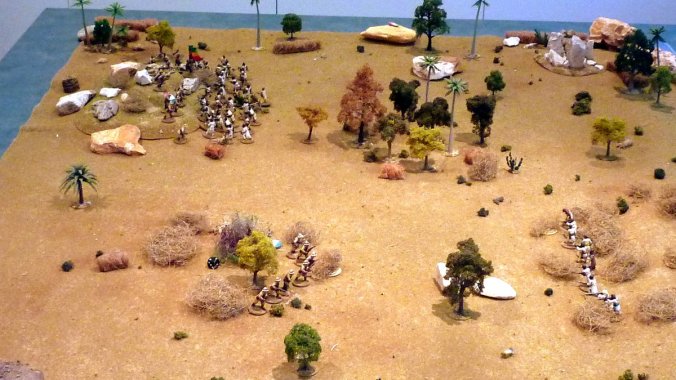
A good view of the chitet riflemen engaging the central fucilieri section as the other two hazbs under the Amsa Aleqa storm the rocky outcrop taking it at sword and spear point.
.
.
.
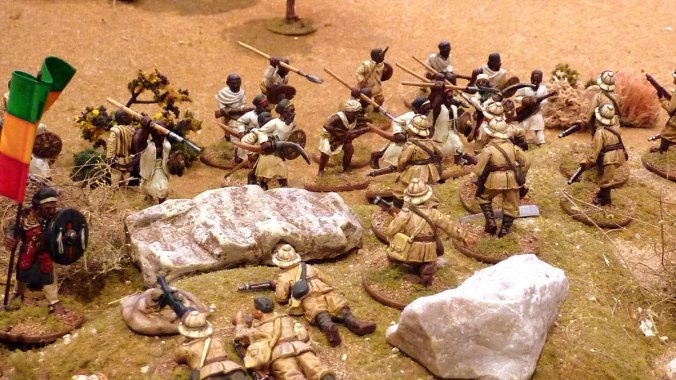
.
.
.

The attack however is not without its implications for the Ethiopian player. The Amsa Aleqa, leading from the front, foolishly one might say, falls in the combat (he rolled a ‘1’ on the wound table) and was killed out right. In addition the Flag bearer is also wounded and reduces its ability to command (i.e. issue orders) by one in the same manner as a leader that loses a command initiative when wounded. This however will mean little as the only senior leader in the Ethiopian force is gone and no further Flag commands may be issued!
This will have an immediate command and control effect on the chitet as their main means of communication is now gone (the senior leader/flag combination) and they will have to rely on straight command dice rolls to activate the remaining forces. Whilst the Ethiopians can be content with the victory they have achieved early on they now may struggle to move forward and with no real firepower ability the Italians can continually dish out ranged fire. Things don’t look quite so good now!
With the victory the Ethiopian motivation level would increase as the Italians lost one force morale point on the Bad Things Happen table for losing a Team wiped out and another two points of force morale for their junior leader being killed. However the loss of their own leader and the wounding of their Flag bearer results in a decrease of their motivation as they lose three force morale points, so their is no net change in the chitet motivation level. Note the large loss of force morale points for the chitet as the loss of leaders effect Ethiopian morale quite significantly. Thus the current Force Morale tally is Italians 7 and the Ethiopians 5. So even though the Ethiopians have had a good measure of success their force morale has taken a blow.
.

Seeing the fate of the comrades on the rocky slope, section two fuclieri look on with trepidation at the enemy in the distance.
.
.
.
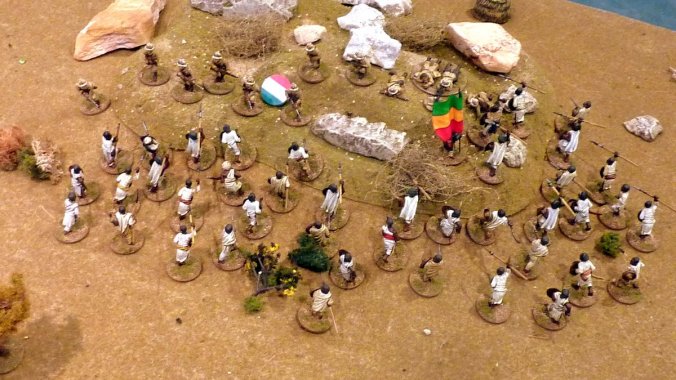
The Italians hang on grimly fighting hard but to no avail.
.
.
.
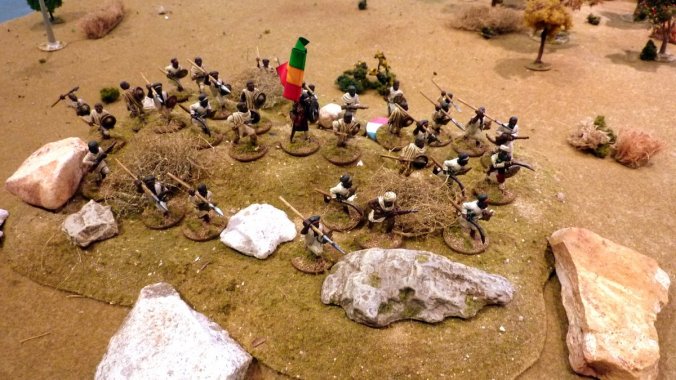
…the posiiton is taken, enemy jump-off point no longer in Italian hands..
.
.
.

The chitet consolidate their win, though their leader has fallen.
.
.
.
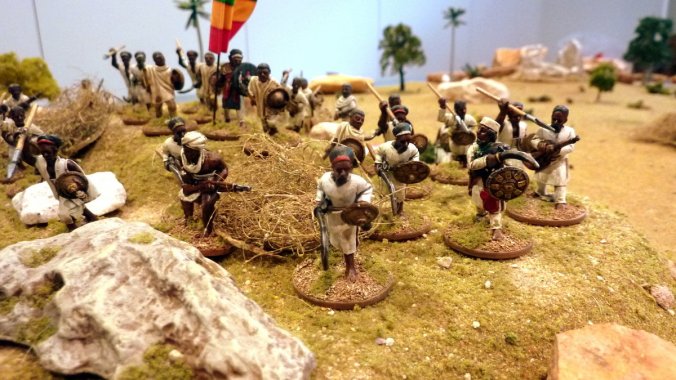
.
.
.
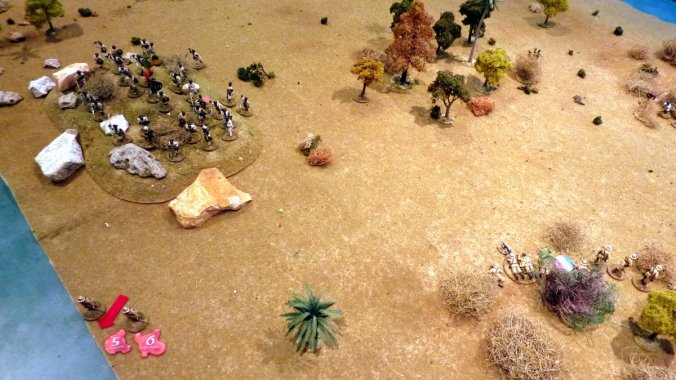
The retreat of the remaining two men of the section is seen here. They rout taking no further part in the action. They have no leader to rally them and are certain to perish should the chitet attack them.
.
.
.

Third Italian section deployed in lower left hand corner in the rocky ground.
With all this Ethiopian activity one could think that the Italian commander was doing nothing at all. However it was but the first few phases and his firepower had not been able to slow the massed assault of the Ethiopian ‘ambush attack’ from their ‘cave complex’. This was a case where the patrol phase had a direct impact on the immediate outcome of the opening phases of the game.
Realising that things were hopeless he needed to get as many of his troops on table as fast as possible whilst also putting out as much firepower as he could. To that end he deployed his third section on table and the senior leader all but completing his deployment barring the FIAT medium machine gun which was needed now more than ever.
A well as gaining a couple of Chain of Command pips he is able to activate the squad leader in section two and the rifle team opens fire on the chitet riflemen opposite their position. The rifle fire is quite effective and the chitet, realising popping up to fire is not such a good idea take, take one casualty and several shock as well. The subsequent fire result test causes them to become Pinned in the scrubby ground.
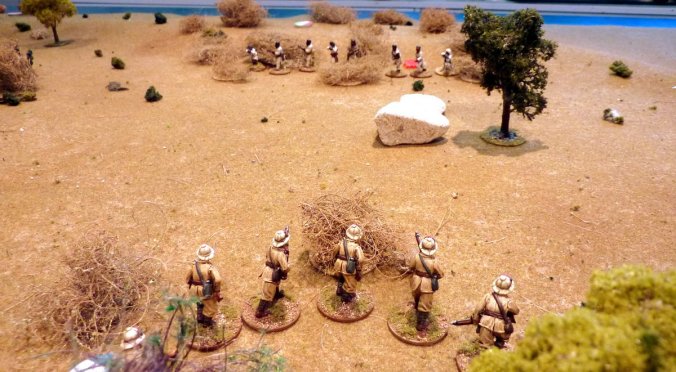
Accurate rifle fire causes the chitet riflemen in the scrub to go to ground ‘Pinned’.
.
.
.
.

Ammist Aleqa arrives with hazb seen on left
The next Ethiopian phase introduces the remaining leader into the fray, the second in command, the Ammist Aleqa (superior junior leader). He comes on with a single hazb making for the small wooded area in the centre of the table. Whilst rolling a ‘2’ the Ethiopian player elects not to move forward into the open, waiting for the third hazb to position itself in the small wood before launching something of a co-ordinated attack. As the baluch senior leader is dead all command responsibilities fall to him!
.
.
.

…and in close up…
.
.
.
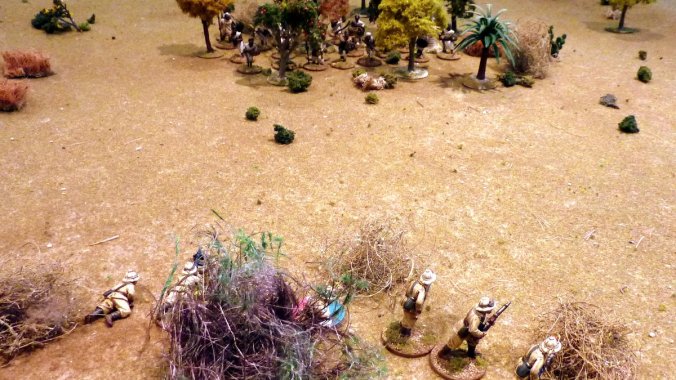
Pushing on the Ammist Aleqa and his hazb enter the treeline opposite the centrally placed section two of the Italians platoon, poised for action. The section commander, looking through his binoculars gets a closer look at the new enemy force before him.
.
.
.

…here they come…
.
.
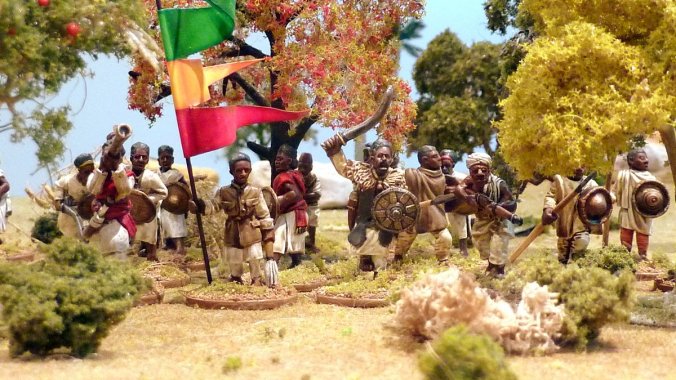
…and closer again…
.
.
φ
So with that we shall end the first of this two part battle report. Up to this point there have been five-six phases and no end of turn as yet.
As things stand the Ethiopians have managed to pull of a coup de main by storming the rocky ground overlooking the main Italian position….virtually an ambush. Their riflemen have put out some desultory fire for no major effect and the second in command and last leader has now pushed forward to see if he can drive off the Italians and overrun their position. The main strike force has stalled and things, whilst initially looking quite good, have broken down somewhat and the Italians are slowly taking a toll on the enemy before them.
The Ethiopians still have one more hazb to deploy just as the Italian tripod mounted machine gun is yet to arrive also. The Italian player has two Chain of Command pips and the Ethiopian have three pips toward a Chain of Command dice. Italian force morale is 7 and the Ethiopian’s 5, with their commitment level set at Motivated.
..can the Italians hang on or will Ethiopian weight of numbers prove too much?









